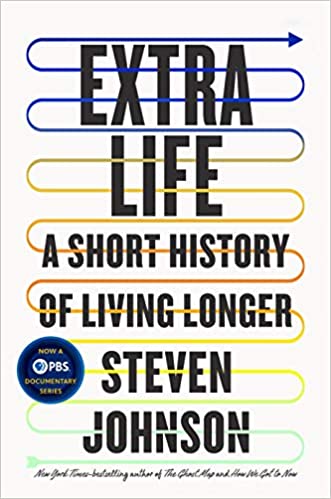You have /5 articles left.
Sign up for a free account or log in.
 Extra Life: A Short History of Living Longer by Steven Johnson
Extra Life: A Short History of Living Longer by Steven Johnson
Published in May 2021
In Extra Life: A Short History of Living Longer, Steven Johnson proposes a thought experiment. Suppose there was such a thing as a 100-year newspaper. Upon that once-a-century publication date in 2021, what would be the lead story?
What would you choose? The invention of the automobile, the airplane or the computer? The devastation of the wars of the 20th century? The building threat of climate change?
To Johnson’s mind, the story we should all be talking about is the doubling of human life expectancy.
In 1900, life expectancy at birth in the U.S. for both sexes and all races was 47.3 years. By 2020, that figure had increased to 77.8 years.
Over the last 50 years, the gains in life expectancy within the developing world have been particularly striking. In India, life expectancy at birth is today around 70 years, up from less than 50 years in 1970.
Looking at these gains in average life expectancy, it is essential to remember that we are not talking about life spans. The overwhelming reasons for gains in life expectancy are the declines in infant and childhood mortality. In 1900, the mortality rate for children under 5 was around 240 deaths for every 1,000 live births. (In 1800, the childhood mortality rate was 462 deaths per 1,000 live births.) By 2020, only seven children out of every 1,000 live births died before their 5th birthday.
Today, we live longer mainly because childhood has been transformed from a time of high risk to one of immense safety.
The decline in childhood mortality is, of course, not the entire story. In the midst of a global pandemic, it can be difficult to keep in mind the range of public health, sanitation, nutritional and medical advances that have transformed the human experience over the past century.
Extra Life is an important counterbalance to the depression that all of us feel as we look forward to finally moving beyond these horrible 18 months of COVID.
Johnson, one of my favorite writers on science and innovation and society, traces historical foundations that have enabled most of us to live longer and healthier lives. This is a story of both the people and the structures (organizations, networks, government agencies) behind the advances that undergird the doubling of life expectancy.
In recounting the history of vaccines, Johnson is at pains to emphasize that the diffusion of vaccination goes well beyond the stories of individual genius and scientific breakthroughs.
In 1796, Edward Jenner came up with the idea to vaccinate for smallpox by causing a mild infection for the related (and less dangerous) cowpox disease. Jenner’s insight followed, however, centuries of variolation -- including the introduction of the technique in England by Lady Mary Wortley Montague in 1721. (She learned the procedure while living in Istanbul.)
Vaccination, however, did not begin to dramatically alter population health (and life expectancy) until governments and international organizations were able to bring the technique to a global scale. It was not until 1975 that smallpox was finally eradicated, with the last case being recorded in a 3-year-old in Bangladesh. Smallpox had been a feared killer throughout history and a major cause of childhood death and hence lower life expectancy. Thanks to efforts by the WHO, today smallpox is only a memory.
Johnson tells a similar story with antibiotics. We all know the story of Alexander Fleming’s serendipitous 1928 discovery of the antibiotic penicillin from a moldy petri dish after returning from vacation. What is less known is the massive U.S. government effort during the Second World War to scale up the manufacture and distribution of penicillin.
As we ponder the Trump administration’s botched response to the pandemic, it is heartening to keep in mind how much worse things might have been. COVID-19 made visible both the public health infrastructure that protects us, as well as the scientific advances that enabled the rapid creation of an effective vaccine.
It may feel too soon to put the COVID-19 pandemic within a broader story of progress. Much of the world is now experiencing unimaginable levels of disease and suffering, as vaccine manufacture and distribution in developing societies have been painfully slow. In the U.S., there remains a significant portion of the population that is vaccine hesitant, slowing down the ability of the country to return to normal pre-pandemic life.
Still, despite not being done with the pandemic, I think right now is precisely when we should be reading Extra Life. Progress is only possible if we understand the choices that enabled past advances.
Our great-grandparents, grandparents and parents fought for the improvements in sanitation, food safety, vaccination, workplace safety, automobile safety and medicine that we take mostly for granted today.
It is good to be reminded of how far we’ve come and what it has taken to get us here.
What are you reading?




